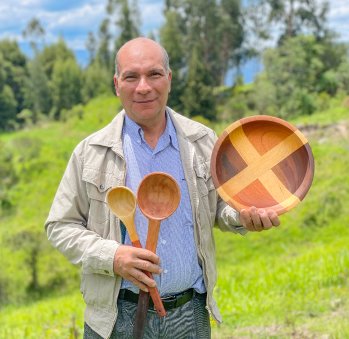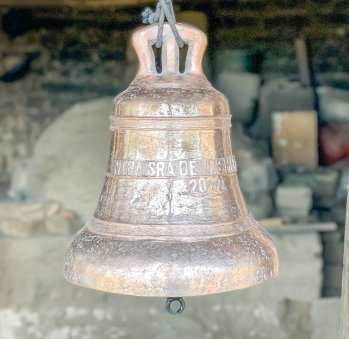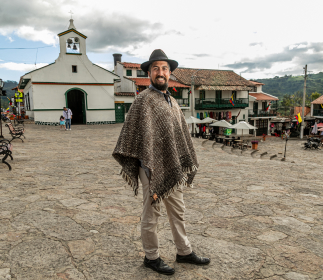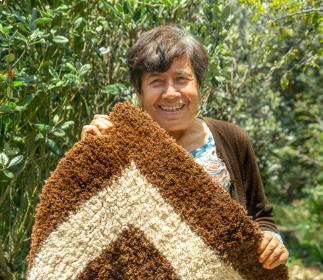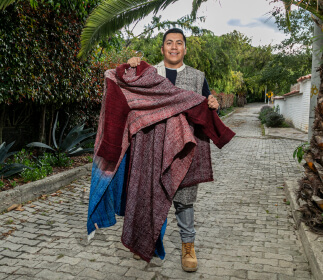Paipa-Iza and Paipa - Guacamayas Route
Back to main routeIf you choose the Tunja-Paipa-Duitama-Nobsa-Monguí option—known locally as the Tundama Province Route, one of Boyacá’s 15 provinces, with Duitama as its capital—, or alternatively the Tunja-Paipa-Iza route—known as the Sugamuxi Route—, you’ll discover a whole new world of craftsmanship and stunning landscapes. This region is a true treasure trove of artisanry. Here you’ll find weaving with different materials, wood carving, the making of soccer balls, and even bells. Pack a jacket as the temperatures can be a bit cooler than in Villa de Leyva—or better yet, discover the benefits of the ruana! This part of Boyacá looks like a postcard, with colonial mansions and churches showcasing beautiful examples of American Baroque. In Duitama, you’ll find the Pueblito Boyacense, a replica of several famous Boyacá monuments and main squares you should know. The nature of the local crafts is so diverse, you could easily make an entire route around it, as we suggest below.
But if you decide to head north from Duitama, you’ll have the chance to discover a little-known corner of Boyacá—its northernmost region, home to the majestic Nevado del Cocuy. You can begin by visiting the basket weavers in Cerinza, a small town that has supplied Colombia for years with the esparto cazuelas you’ll recognize instantly. From there, your journey will continue upward through towns and mountains, crossing Belén, Páramo, Susacón, Soatá, Boavita, La Uvita, and San Mateo before arriving in Guacamayas, in the Gutiérrez Province—an unexpected gem that welcomes all those adventurous enough to make it that far. There, you’ll discover the baskets that earned this town a Denomination of Origin, and how local life revolves around their intricate weaving traditions. Once you’ve reached this point, the most adventurous travelers will be just a short distance away from the incredible landscapes of the Nevado del Cocuy.
Embark on a journey full of history

Artisans along the way
Artisans along the way
We recommended this tour
Schedule the visit in advance with the artisans.
Carry cash
4 days
Car or Bus

PAIPA – DUITAMA
We suggest spending two days here, or at least a day and a half. Depending on your schedule, you could start or end your day in Paipa, a town famous for its hot springs which you absolutely can’t miss. Not only are they delightfully warm, but they also have medicinal properties! In addition to enjoying the spa and delicious local cuisine, you can visit the Méndez family and Wilmer Pulido, renowned weavers, where you’ll find some of the finest ruanas in the region. Then, head towards Duitama, just 13 kilometers away. You could easily spend a day here meeting local artisans and visiting their workshops, where you can learn about wool weaving, crochet, leatherwork, and wood carving. Don’t miss the colorful Pueblito Boyacense, the Miniature Village that’s a symbol of the department, where you’ll see replicas of the famous Villa de Leyva square, sculptures from Ráquira, church facades, and the iconic monument to Los Lanceros del Pantano de Vargas by Rodrigo Arenas Betancur. The entry fee is modest, and parking is convenient, plus you can savor all the Boyacá delicacies while you’re there. It’s a picturesque spot that embodies the region’s rich artisan culture.
DUITAMA – PUNTA LARGA
Only 8 km from Duitama, Punta Larga is another must-see destination on any Boyacá tour because of its stunning landscape. Here, you’ll meet the master wood carvers who craft the colonial-style furniture you’ll find in hotels, restaurants, and traditional homes throughout the region. While in Punta Larga, make sure to visit the Marqués de Punta Larga vineyard, a regional icon known for its excellent wines. This charming vineyard guarantees a delightful time with great food and a selection of smooth wines. This is the perfect opportunity to immerse yourself in the area’s artisan culture and admire the Spanish heritage present in the region’s architecture.
PUNTA LARGA – NOBSA – MONGUÍ
Next, head to Nobsa, just 9 km away, and discover this lovely town, known as the birthplace of the ruana. You’ll see how essential sheep’s wool is here, with weaving happening in nearly every home. While you’re here, one of the greatest discoveries of the department awaits: the opportunity to see bell-making in action with the family who has been perfecting this craft for generations. Take time to meet the local artisans we recommend; you can spend the night here or head to Monguí, just 40 minutes (20 km) away. Monguí is one of the most beautiful towns in Boyacá, and you should definitely spend a full day exploring it. Once an important Muisca chiefdom before the Spanish colonization, it later became a center of Catholic evangelization, which is the reason for its Nuestra Señora de Monguí Church to be stunning. The people of Monguí are devoted to Nuestra Señora de la Concepción, who is believed to have performed miracles, making pilgrimage a key event for the town. But Monguí isn’t just known for its religious devotion; it’s also the birthplace of the iconic hand-sewn soccer balls that have given the town a strong identity. Enjoy watching the balls hanging in the streets and observe the women weaving them. Visit our recommended artisan to understand the importance of this craft. Monguí is also the home of the famous gualdrapas, colorful woolen rugs that decorate the traditional Boyacá homes.


PUNTA LARGA - TIBASOSA – IZA - TOTA
At Punta Larga, you’ll need to make a choice: either continue on to Monguí or head towards Iza. If you choose the latter, let yourself be tempted by the sweet scent of feijoa fruits, a regional delicacy that is popular in Tibasosa (8 km away) and Iza (25 km away). End your trip with a visit to the breathtaking Laguna de Tota (36 km away), an enormous lake with a stunning blue hue. Iza, known as the Green Nest of Boyacá, is a town with a long tradition of weaving and is recognized as a cultural heritage site due to its rich historical, natural, and culinary wealth, including the Pozo Verde hot springs. The town’s compact size makes it one of the seven Nativity towns of Colombia. Visit the Divino Salvador de la Piedra de Iza Temple, built in adobe in 1678. While you’re walking around, you’ll encounter a cypress pine tree with the effigy of Francisco Cristancho, the composer of the famous “Torbellino de mi tierra”. This pine tree is itself a local treasure, planted by the Chorographic Commission in 1850. Iza also boasts murals and monuments throughout the town, along with excellent dining options (don’t miss the local trout), cozy accommodations, and glamping. If you’re into ecotourism, get ready for cycling and hiking.
CERINZA-GUACAMAYAS
You can stay overnight in Duitama and make an early start toward Cerinza, just half an hour away. We recommend beginning your day early so you can witness the transformation of the landscape as the morning mist lifts with the warming air, revealing lush green pastures and the imposing Cerro del Tíbet, which will watch over your visit like a quiet guardian. In Cerinza, you’ll experience two types of artisan life: one rooted in the town, and another in the countryside, thanks to two groups of esparto artisans. With Nelcy, you’ll get a taste of local life while she weaves baskets, placemats, and the cazuelas that are a staple on Cundinamarca and Boyacá tables—perfect for serving snacks, empanadas, or a steaming bowl of ajiaco. With the women of ADAUC, you’ll get a glimpse into rural routines, where weaving is interwoven with tending cattle and crops. Don’t miss the chance to book a traditional lunch with them!
In the afternoon, you can visit the Gothic-style Church of the Immaculate Conception and the colonial Chapel of Santa Lucía. Or, if you prefer nature, head to El Paraíso Sports Club, a family-friendly farm in the Novare area, where you can try your luck at archery or paintball. Another option is to hike up Cerro de las Cruces for a panoramic view of Cerinza. If you’re eager to explore the surrounding mountains more deeply, extend your visit by a day and hike to the Careperro Lagoon. The trek is on foot, and the reward is arriving at its still waters, framed by frailejones and misty páramo clouds.
Nearly five hours from Cerinza, in the far north of Boyacá, you’ll find Guacamayas. Take your time on the road and make the most of the journey by visiting the charming towns along the way: Belén, with its grid-pattern streets and plaza lined with towering palm trees; Susacón, with its viewpoint over the Chicamocha Canyon at Alto Cruz de Mayo; Soatá, with its colorful murals on Calle del Comercio and stunning natural surroundings; La Uvita, known for its rolling hills; and San Mateo, where you’ll find the historical Casa Redonda.
Reaching Guacamayas will be more than worth it. The town will appear suddenly between the curves of the road—hence its nickname, the “surprise town.” Nestled on a mountainside, locals say it has every climate—and they’re not wrong! Down in the town, the weather is warm and welcoming, like its people. But climb up the mountain, and you’ll gradually feel the need to bundle up. In its surroundings, you’ll find fields of sugarcane, coffee, potatoes, and maize. In town, a clean and colorful environment fosters the blooming of the orchids that fill its gardens. Don’t miss the trail Los Moros, the San Diego Alcalá parish, and the San Diego and Recycling Ecological Parks. Spend your afternoon wandering the streets or strolling along the Orchid Trail, and be sure to try a local delicacy: chorotas soup. The next day, dive deep into the artisanry that earned Guacamayas its Denomination of Origin, guided by Omaira Manrique, an unstoppable community leader, and Francisco Silva, recipient of the Contemporary Craftsmanship Mastery Medal, as well as the members of Asoartesgua. You’ll come to appreciate the delicate techniques and the rich heritage passed down from their Lache ancestors.
To top it all off, take advantage of the chance to visit the Nevado del Cocuy—a breathtaking landscape and a sacred territory for the U’Wa indigenous people. From Guacamayas, you’re only about thirty minutes away from the towns of Cocuy, an architectural heritage town, or Güicán. In both, you can arrange your permits and insurance for entering the park, and you’ll find plenty of cabins and lodges to rest in before beginning your high-altitude adventure into the National Natural Park of El Cocuy. On your way back down, reward yourself with a relaxing soak in the hot springs of La Salinita in El Espino or those in San Luis, Güicán.

Route acknowledgement
Recommended sites
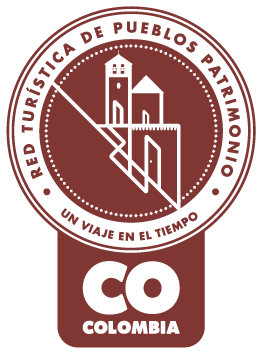
Pueblo Patrimonio
La Red Turística de Pueblos Patrimonio de Colombia es un programa especial del Ministerio de Comercio, Industria y Turismo, ejecutado por FONTUR, que trabaja con 17 municipios de Colombia que poseen declaratoria de Bien de Interés Cultural (BIC) a nivel nacional para su valoración y proyección mediante el turismo, generando así más oportunidades de desarrollo y sostenibilidad en las comunidades.

La Medalla a la Maestría Artesanal es un galardón que Artesanías de Colombia entrega anualmente, con el cual se hace un reconocimiento a aquellos artesanos, empresas y comunidades artesanales que, contando con una trayectoria destacada, sobresalen a nivel nacional por su excelencia en el oficio así como por preservar el quehacer artesanal.

Denominación de Origen
Es un signo distintivo que identifica productos reconocidos o famosos por tener una calidad o características específicas derivadas esencialmente del lugar de origen y la forma tradicional de extracción, elaboración y producción por parte de sus habitantes. La protección conferida sobre una Denominación de Origen implica que ninguna persona puede identificar con la denominación protegida productos iguales o similares a los amparados, cuando no provengan del verdadero lugar y no cumplan con las características o calidades que le han dado la reputación al producto reconocido. Las Denominaciones de Origen para productos artesanales colombianos que han sido protegidas por la Superintendencia de Industria y Comercio en nuestro país son actualmente 12.
No puede copiar contenido de esta página














































